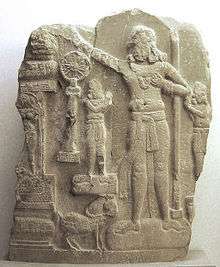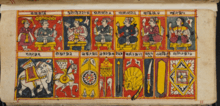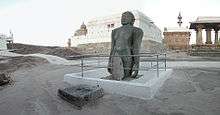Chakravarti (Sanskrit term)
In Indian religions, the term chakravarti (Sanskrit: चक्रवर्तिन् cakravartin, Pali: cakkavatti) refers to an ideal universal ruler[1] especially in the sense of an imperial ruler of the entire Indian sub-continent (as in the case of the Maurya Empire despite not conquering the southern kingdoms).[2] The first references to a Chakravala Chakravartin appear in monuments from the time of the early Maurya Empire, in the 4th to 3rd century BCE, in reference to Chandragupta Maurya and his grandson Ashoka.

The word cakra-vartin- is a bahuvrīhi compound word, translating to "one whose wheels are moving", in the sense of "whose chariot is rolling everywhere without obstruction". It can also be analysed as an 'instrumental bahuvrīhi: "through whom the wheel is moving" in the meaning of "through whom the Dharmachakra ("Wheel of the Dharma) is turning" (most commonly used in Buddhism). The Tibetan equivalent Tibetan: ཁོར་ལོས་སྒྱུར་བའི་རྒྱལ་པོ་, Wylie: khor los sgyur ba'i rgyal po translates "monarch who controls by means of a wheel".

In Buddhism, the Chakravarti came to be considered the secular counterpart of a Buddha. In general, the term applies to temporal as well as spiritual kingship and leadership, particularly in Buddhism and Jainism. In Hinduism, the term generally denotes a powerful ruler whose dominion extended to the entire earth.
The Indian concept of Chakravarti later evolved into devaraja concept of divine right of kings, which was adopted by the indianised Hindu-Buddhist kingdoms of Southeast Asia through Indian Hindu Brahmins scholars deployed in courts. It was first adopted by Indonesian Hindu-Buddhist empires (Srivijaya and Majapahit) and through them by various Indianised Malay kingdoms, then by the Khmer Empire, and subsequently by the Thai monarches.
Buddhism
It was believed that once a cakravati emerged the "Future Buddha" Maitreya would appear on earth.[3]
In early Buddhist art there are more than 30 depictions, all from the Deccan. In most the Cakravarti King uses the "Royal Gesture" in which the king "clenches his left hand at his chest and reaches up with his right hand". He is surrounded by his seven attributes: the Chakraratna wheel, his state elephant, charger horse, "the octagonal gem which is so luminous it can light the path of his army by night", his queen, prime minister and finance minister.[4]
The early Buddhist Mahāvastu (1.259f) and the Divyāvadāna, as well as the Theravadin Milindapañha, describe the marks of the cakravarti as ruler: uṣṇīṣa, chhatra "parasol", "horn jewel" or vajra, whisk and sandals. These were the marks of the kshatriya. Plastic art of early Mahayana Buddhism illustrates bodhisattvas in a form called uṣṇīṣin "wearing a turban/hair binding", wielding the mudras for "nonviolent cakravarti rule".[5]
A Cakravarti King is a king who rules all of the great continents (Pubbavideha, Jambudipa, Aparagoyana, Uttarakuru) of earth. The King wins all of the continents with peace. Since he is virtuous, seven miracle treasures appear including a large wheel spinning (Chakraratnaya) in the sky. The king and his army can travel anywhere with that spinning wheel in the sky. He travels over the world and teaches all kings how to rule with peace Dasavidha-rājadhamma. He can travel to the lower heaven realms with the power of Chakraratnaya if he wants. Cakravarti king only appears when humans are virtuous and long lived. Jataka tales, a part of the Pali Canon, describe Buddhist Cakravarti Kings.
Hinduism
According to the traditions "Vishnu, in the form of Chakra, was held as the ideal of worship for Kings desirous of obtaining Universal Sovereignty",[6] a concept associated with the Bhagavata Puranas, a religious sanction traceable to the Gupta period,[7] which also led to the Chakravartin Concept.[8] There are relatively few examples of chakravartins in both northern and southern India.
In Southern India, the Pallava period beginning with Simhavishnu (575 CE – 900 CE) was a transitional stage in southern Indian society with monument building, establishment of (bhakti) sects of Alvars and Nayanars, flowering of rural Brahmanical institutions of Sanskrit learning, and the establishment of Chakravartin model of kingship over a territory of diverse people; which ended the pre-Pallavan era of territorially segmented people, each with their culture, under a tribal chieftain.[9] The Pallava period extolled ranked relationships based on ritual purity as enjoined by the shastras.[10] Burton distinguishes between the Chakravatin model and the Kshatriya model, and likens kshatriyas to locally based warriors with ritual status sufficiently high enough to share with Brahmins; and states that in south India the kshatriya model did not emerge.[10] As per Burton, South India was aware of the Indo-Aryan Varna organized society in which decisive secular authority was vested in the Kshatriyas; but apart from the Pallava, Chola and Vijayanagar line of warriors which claimed Chakravartin status, only few locality warrior families achieved the prestigious kin-linked organization of northern warrior groups.[10]
Jainism

During the each motion of the half-cycle of the wheel of time, 63 Salakapurusa or 63 illustrious men, consisting of the 12 Chakravartin regularly appear.[11][12] The Jain cosmology or legendary history is basically a compilation of the deeds of these illustrious men. As per Jain cosmology, Chakravartins are Universal Monarchs or World Conquerors. Golden in complexion, they all belonged to the Kasyapa gotra. The mother of a Chakravartin sees some dreams at the time of conception. A chakravartin is considered an ideal human being endowed with thirty-two major signs of excellence and many minor signs of excellence.
The list of 12 chakravartin of Avasarpini as per Jainism is as follows[13]
- Bharata, son of Tirthankara Rishabhanatha
- Sagara, ancestor of Bhagiratha as in the Puranas
- Maghava[14]
- Sanatkumara[14]
- Tirthankara Shantinatha
- Tirthankara Kunthunatha[15]
- Tirthankara Aranatha[15]
- Subhauma[15]
- Padmanabha
- Harishena
- Jayasena
- Brahmadatt
In Jainism, a Chakravartin Samrat was characterised by his possession of Saptaratna, or "Seven Jewels":
- Ratna-Chakra, a miraculous diamond serrated discus that never misses its target
- Empress
- Divine Jewellery
- Immense Wealth
- Huge Army of War-Chariots
- Huge Army of Cavalry
- Huge Army of Elephants
Some lists cite navaratna or "nine jewels" instead, adding "Prime Minister" and "Son".
See also
| Wikimedia Commons has media related to Chakravartins. |
Similar Indic concepts
Generic similar concepts
Spread and evolution of Chakravarti concept beyond India
References
Citations
- Gopal, Madan (1990). K.S. Gautam (ed.). India through the ages. Publication Division, Ministry of Information and Broadcasting, Government of India. p. 81.
- Rosenfield, 175
- Rosenfield, 175
- Rosenfield, 175-176
- Falk, Harry, "Small-Scale Buddhism" in Voegeli, François; Eltschinger, Vincent; Candotti, Maria Piera; Diaconescu, Bogdan; Kulkarni, Malhar, eds. (2012). Devadattīyam : Johannes Bronkhorst felicitation volume. Bern: Peter Lang. ISBN 9783034306829., p. 495
- Wayne Edison Begley (1973). Viṣṇu's flaming wheel: the iconography of the Sudarśana-cakra, p.48. Volume 27 of Monographs on archeology and fine arts. New York University Press
- Śrīrāma Goyala, (1967). A history of the Imperial Guptas, p.137. Central Book Depot.
- Wayne Edison Begley (1973). Viṣṇu's flaming wheel: the iconography of the Sudarśana-cakra, p.65. Volume 27 of Monographs on archaeology and fine arts. New York University Press
- Burton Stein (1980). Peasant state and society in medieval South India. Oxford University Press. pp. 63–64.
- Burton Stein (1980). Peasant state and society in medieval South India. Oxford University Press. p. 70.
- Jaini 1998.
- Doniger 1999, p. 550.
- Jaini, Jagmanderlal, F.W. Thomas (ed.), Outlines of Jainism appendix III.
- von Glasanapp 1999, p. 306.
- von Glasanapp 1999, p. 308.
Sources
- Doniger, Wendy, ed. (1999), Encyclopedia of World Religions, Merriam-Webster, ISBN 0-87779-044-2
- von Glasenapp, Helmuth (1 January 1999), Jainism: An Indian Religion of Salvation, Delhi: Motilal Banarsidass, ISBN 81-208-1376-6
- Dictionary of Hindu Lore and Legend (ISBN 0-500-51088-1) by Anna Dallapiccola
- Rosenfield, John M., The Dynastic Arts of the Kushans, 1967, University of California Press, ISSN 0068-5909, google books
- Cakkavatti Sutta The Wheel-turning Emperor (excerpt) Translated from the Pali by Thanissaro Bhikkhu
- A Glossary of Pali and Buddhist Terms
.svg.png)